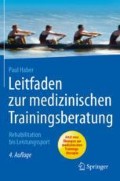Zusammenfassung
Ernährung im Sport ist nur optimal im Hinblick auf eine bestimmte Zielstellung. Optimale Ernährung ermöglicht die Realisierung der durch Training angelegten Potenziale, aber schafft keine zusätzlichen. Für den Energieumsatz und die Nährstoffzusammensetzung werden Bilanzen erstellt. An erster Stelle steht der bei Sportlern sehr variable Tagesenergieumsatz, denn: Jeglicher Nährstoffbedarf nimmt dazu proportional zu oder ab. Körperfett zu- oder abnehmen ist das Problem der Energiebilanz. Von den energietragenden Nährstoffen wird der Proteinbedarf noch durch die muskuläre Beanspruchung definiert. Für Ausdauersportler ist der Kohlenhydratanteil von Bedeutung und auch der Ersatz während der Belastung bei umfangreichem Training oder Wettkampf. Die Flüssigkeitsbilanz ist bei umfangreichem Training und bei hohen Temperaturen zu beachten. Bei starkem Schweißverlust muss dem Getränk Kochsalz zugemischt werden.
Access this chapter
Tax calculation will be finalised at checkout
Purchases are for personal use only
Literatur
Atkins RC (2003) Diät-Revolution. Frankfurt/Main, Fischer
Böttcher H (2004) Thermogenese weißer Adipocyten von normalgewichtigen und adipösen Probanden. 2016, from https://www.uni-hohenheim.de/wwwin140/MITARB/boettcher/thermogenese.htm
Church TS, Thomas DM et al. (2011) Trends over 5 decades in U.S. occupation-related physical activity and their associations with obesity. PLoS One 6, e19657 DOI: 10.1371/journal.pone.0019657
Coyle EF (2004) Fluid and fuel intake during exercise. Food, nutrition and sport performance II; the International Olympic Committee, consensus on sports nutrition. R. J. Maughan, L. M. Burke and E. F. Coyle. London, New York, Routledge, Taylor and Francis Group: 63–91
Eckel RH, Jakicic JM et al. (2014) 2013 AHA/ACC Guideline on Lifestyle Management to Reduce Cardiovascular Risk; A Report of the American College of Cardiology/American Heart Association/Task Force on Practice Guidelines. Circulation; http://circ.ahajournals.org/content/early/2013/11/11/01.cir.0000437740.48606.d1.citation
Haber P (2004) Magnesium update. Acta Med Austriaca 31: 37–39
Haber P, Lercher P (2001) Über den Zusammenhang von Bewegung und Körpergewicht. Collegium publicum 6: 2–3
Karvonen MJ, Kentala E et al. (1957) The effects of training on heart rate. A longitudinal study. Ann Med Exper Fenn 35: 307–315
Lukaski HC, Nielsen FH (2002) Dietary Magnesium Depletion Affects Metabolic Responses during Submaximal Exercise in Postmenopausal Women. J. Nutr. 132: 930–935
Mainer M (2005) Der Einfluss von Magnesiumsupplementation auf die ergometrische Leistungsfähigkeit bei gesunden, untrainierten Männern in der 3. Lebensdekade Diplomarbeit, Universität Wien; Inst. f. Ernährungswissenschaften
Marchart P (2002) Anthropometrisch und altersbezogene Referenzwerte für die Maximalkraft und Kraftausdauer bei Kindern (ab 12 J.), Jugendlichen und Erwachsenen, Universität Wien
Montain SJ, Slawka MN et al. (2001) Hyponatriemia associated with exercise: Risk factors and pathogenesis. Exerc Sport Sci Rev 29: 113–117
Shirreffs SM, Armstrong LE et al. (2004) Fluid and electrolyte needs for preparation and recovery from training and competition. J Sports Sciences 22: 57–63
Shirreffs SM, Maughan RJ (1998) Volume repletion after exercise-induced volume depletion in humans: replacement of water and sodium losses. Am J Physiol 274: F868–F875
Slatner A (2015) Studie sieht veränderte Ernährungsgewohnheiten – Spanien, Australien und Samoa essen besonders fett; https://kurier.at/wirtschaft/fettkonsum-oesterreich-unter-den-top-ten-weltweit/156.945.211.2016
Strasser B, Spreitzer A et al. (2007) Fat loss depends on energy deficit, independently of the method for weight loss. Ann Nutr Metab 51: 428–432
Tipton KD, Wolfe RR (2004) Protein and amino acids for athletes. Food, nutrition and sport performance II; the International Olympic Committee, consensus on sports nutrition. R. J. Maughan, L. M. Burke and E. F. Coyle. London, New York, Routledge, Taylor and Francis Group: 104–129
Wieser M, Haber P (2007) The effects of systematic resistance training in the elderly. Int J Sports Med 28: 59–65
Author information
Authors and Affiliations
Rights and permissions
Copyright information
© 2018 Springer-Verlag GmbH Deutschland
About this chapter
Cite this chapter
Haber, P. (2018). Ernährungsbilanzen für eine ausgewogene Ernährung. In: Leitfaden zur medizinischen Trainingsberatung. Springer, Berlin, Heidelberg. https://doi.org/10.1007/978-3-662-54321-4_25
Download citation
DOI: https://doi.org/10.1007/978-3-662-54321-4_25
Published:
Publisher Name: Springer, Berlin, Heidelberg
Print ISBN: 978-3-662-54320-7
Online ISBN: 978-3-662-54321-4
eBook Packages: Medicine (German Language)

